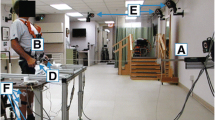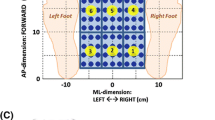Abstract
This paper presents a contribution for restoring standing in paraplegia while using functional electrical stimulation (FES). Movement generation induced by FES remains mostly open looped and stimulus intensities are tuned empirically. To design an efficient closed-loop control, a preliminary study has been carried out to investigate the relationship between body posture and voluntary upper body movements. A methodology is proposed to estimate body posture in the sagittal plane using force measurements exerted on supporting handles during standing. This is done by setting up constraints related to the geometric equations of a two-dimensional closed chain model and the hand–handle interactions. All measured quantities are subject to an uncertainty assumed unknown but bounded. The set membership estimation problem is solved via interval analysis. Guaranteed uncertainty bounds are computed for the estimated postures. In order to test the feasibility of our methodology, experiments were carried out with complete spinal cord injured patients.








Similar content being viewed by others
References
Denavit J, Hartenberg RS (1955) A kinematic notation for lower pair mechanism based on matrices. J Appl Mech 22:215–221
Donaldson N, Yu C (1996) Fes standing control by handle reactions of leg muscle stimulation (chrelms). IEEE Trans Rehabil Eng 4:280–284
Donaldson N, Yu CH (2000) Experiments with chrelms patient-driven stimulator controllers for the restoration of function to paralysed legs. Proceedings Intitution of Mechanical Engineers Part H. J Eng Med 214(1):1–20
Guiraud D, Taroni G, Denis B, Couderc P, Stieglitz T (2000) Description of a sixteen-channel fes implantable system. In: Proceedings of the 5th annual conference of the International Functional Electrical Stimulation Society (IFESS)
Guiraud D, Poignet P, Wieber PB, Makssoud H, Pierrot F, Brogliato B, Fraisse P, Dombre E, Divoux J, Rabischong P (2003) Modelling of the human paralysed lower limb under fes. In: ICRA, special session on medical robotics, Taipei, Taiwan, pp 2218–2223
Guiraud D, Stieglitz T, Koch KP, Divoux JL, Rabischong P (2006) An implantable neuroprosthesis for standing and walking in paraplegia : 5-year patient follow-up. J Neural Eng 3:268–275
Héliot R, Azevedo C, Espiau B (2007) Functional rehabilitation: coordination of artificial and natural controllers. ARS (Advanced Robotic Systems) Rehabilitation Robotics
Jaulin L, Kieffer M, Didrit O, Walter E (2001) Applied interval analysis: with examples in parameter and state estimation, robust control and robotics. Springer, London
Riener R, Fuhr T (1998) Patient-driven control of fes-supported standing up: a simulation study. IEEE Trans Rehabil Eng 6(2):113–124
Riener R, Ferrarin M, Pavan EE, Frigo CA (2000) Patient-driven control of fes-supported standing up and sitting down: experimental results. IEEE Trans Rehabil Eng 8(4):523–529
Acknowledgments
The authors would like to specially thank all the participants for giving so much time and making this study possible. We gratefully acknowledge Propara rehabilitation center for giving us the opportunity to work in the best conditions during the experiments. Also thanks to industrial partner MXM (Vallauris, France) for technical and financial support as well as ANR-RNTS, MIMES project. We also would like to acknowledge the contributions made to this study by our partners from the EDM (Efficience et Déficience Motrice) laboratory, Université de Montpellier I (Montpellier, France), and fundings from COLOR INRIA, Posture project.
Author information
Authors and Affiliations
Corresponding author
Rights and permissions
About this article
Cite this article
Pages, G., Ramdani, N., Fraisse, P. et al. A method for paraplegic upper-body posture estimation during standing: a pilot study for rehabilitation purposes. Med Biol Eng Comput 47, 625–633 (2009). https://doi.org/10.1007/s11517-009-0470-z
Received:
Accepted:
Published:
Issue Date:
DOI: https://doi.org/10.1007/s11517-009-0470-z




